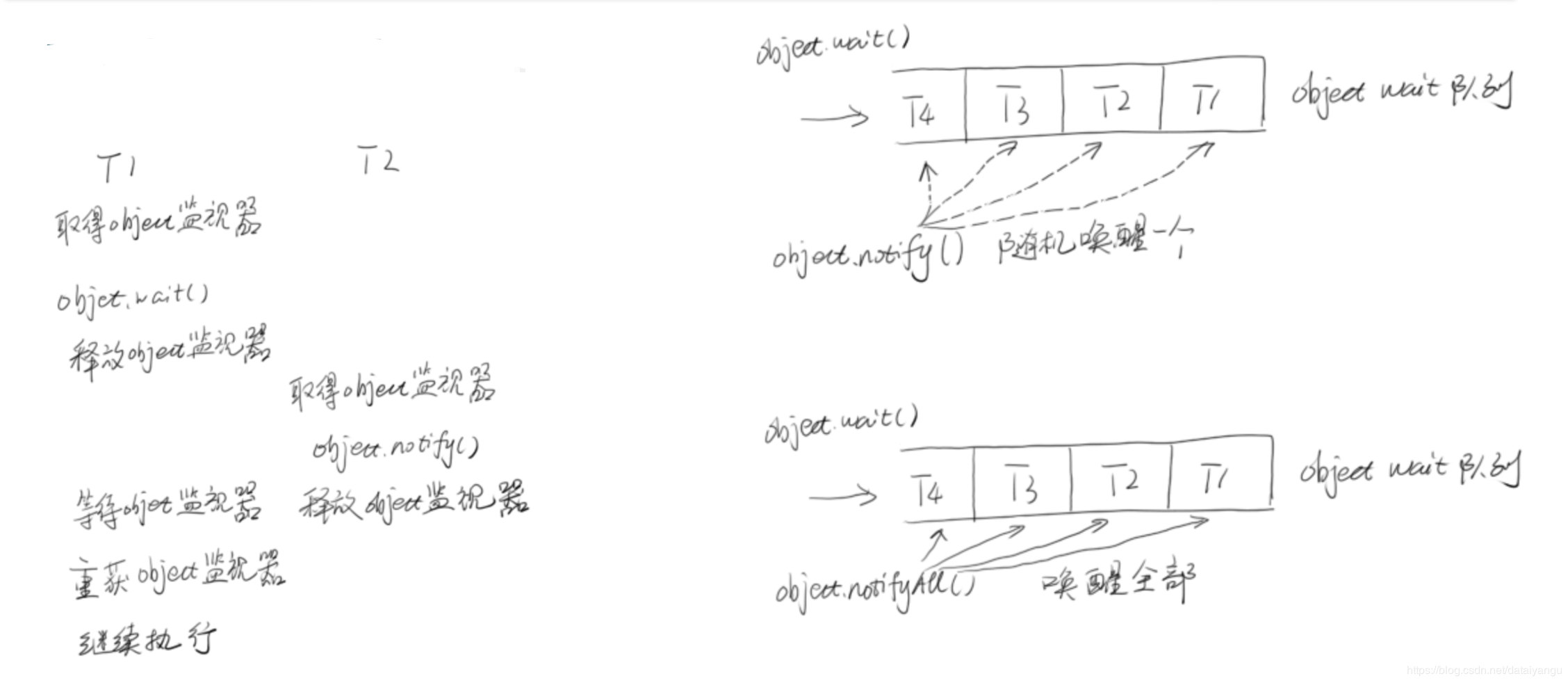转自:https://blog.csdn.net/dataiyangu/article/details/86226835#
什么是线程?
线程的基本操作
线程的基本操作
新建线程
调用run的一种方式
调用run另的一种方式
终止线程 **(弃用)**
中断线程
挂起(suspend)和继续执行(resume)线程 ** (弃用)**
等待线程结束(join)和谦让(yeild)
yeild
join
守护线程
线程优先级
基本的线程同步操作
synchronized ** (注意拿到的东西必须是同一个)**
Object.wait() Obejct.notify()
什么是线程?
线程是进程内的执行单元。
每个进程中有若干个线程,进程的切换是非常重量型的,所线程可以作为较为广泛的并发涉及
java中调动了线程会映射到操作系统中,两者是等价的
线程的基本操作

线程的基本操作
新建线程
Thread t1=new Thread(); t1.start();
每一个线程都是runable接口的实现
start方法就能把这个线程跑起来,开启一个线程
在一个新的操作系统的线程上面调用run方法
Thread t1=new Thread(); t1.run();
不能开启线程
调用run方法和调用start方法做的事情是一样的 ,但是run并不会开启新的线程而是在调用run的当前的这个线程当中执行这个操作,只有使用的start方法才是在真的一个新的线程当中执行run中的事情
Thread.run()的实现 target 是Runnable接口(run是runnable接口中的一个方法)
run方法源码
private Runnable target;
public void run() {
if (target != null) {
target.run();
} }
Thread 的init方法:
public Thread(){
init(null,null,"Thread-"+nextThreadNum(),0)
//init方法是在new对象的时候自动执行的
}
private void init(ThreadGroup g, Runnable target, String name,
long stackSize) {
init(g, target, name, stackSize, null, true);
}
调用run的一种方式
这里的target本身就是传的null,所以就可以把run方法重载,把我们的方法写进去
Thread t1=new Thread(){
@Override
public void run(){
System.out.println("Hello, I am t1");
} };
t1.start();
调用run另的一种方式
将target传到init方法中,来运行run方法。如下面CreateThread3(一个runnable的实例),这里不需要重载run方法,t1.start()的时候会自动去调用target.run。
Thread t1=new Thread(new CreateThread3()); t1.start();
1
终止线程 (弃用)
– Thread.stop() 不推荐使用。它会释放所有monitor
记录1:ID=1,NAME=小明
记录2:ID=2,NAME=小王

如上图,在读和写的时候加入锁,当写完id,正要写name的时候,stop掉了thread,这个时候,会把锁释放掉,导致将id写了进去,name没有写进去,出现数据的不一致。
中断线程
public void Thread.interrupt() // 中断线程
public boolean Thread.isInterrupted() // 判断是否被中断
public static boolean Thread.interrupted() // 判断是否被中断,并清除当前中断状态
public void run(){ while(true){
Thread.yield();
} }
t1.interrupt();
t1.interrupt();我只是告诉线程你应该终止了,对线程没有任何的影响,还是在跑着的。
public void run(){ while(true){
if(Thread.currentThread().isInterrupted()){
System.out.println("Interruted!");
break;
}
Thread.yield();
} }
通过Thread.currentThread().isInterrupted()判断当前的线程是不是被interrupt(),告知过要中断,是的话就break出while循环,同时终止run方法,也就自动终止了thread,这里不会出现数据的不一致,因为是在Thread.yield();(下一次数据处理之前)对线程进行终止的。
拓展
public static native void sleep(long millis) throws InterruptedException
public void run(){ while(true){
if(Thread.currentThread().isInterrupted()){
System.out.println("Interruted!");
break; }
try {
Thread.sleep(2000);
} catch (InterruptedException e) {
System.out.println("Interruted When Sleep");
//设置中断状态,抛出异常后会清除中断标记位
Thread.currentThread().interrupt();
}
Thread.yield();
}
}
sleep即休眠方法。为什么休眠方法需要抛出 throws InterruptedException异常呢?
如果我在休眠的过程中,线程出现了isInterrupted(中断)的请求怎么办?这个时候如果sleep会抛出一个异常,同时自动清除interrupt()设置的标志位,所以需要在抛出的异常中添加Thread.currentThread().interrupt();以保证能够被上面的Thread.currentThread().isInterrupted()检测到从而中断线程。
挂起(suspend)和继续执行(resume)线程 (弃用)
suspend()不会释放锁 ,发现suspend之后现场称还是runnable的状态,当然不代表所有的挂起后线程会runnable。
如果加锁发生在resume()之前 ,则死锁发生

如上图,线程1挂起可,这个时候没有释放锁,希望通过线程2来resume锁,但是线程2的resume可能意外的发生在suspend之前,这个时候线程1将会永远的挂,其他的锁(如上图线程3)将会无线等待线程1拿到的锁。
等待线程结束(join)和谦让(yeild)
yeild
当前线程优先级不是特别高,希望其他线程有机会争夺cpu时间,所以讲当前占用的cpu事件释放掉,使得其他的线程有更多的机会继续往下执行,但是下次还是有机会拿到cpu时间,不代表永远的让出去。
join
线程a希望知道线程b什么时候结束,因为需要在线程b结束的时候来立马做某些事情。
public class JoinMain {
public volatile static int i=0;
public static class AddThread extends Thread{
@Override public void run() {
for(i=0;i<10000000;i++); }
}
public static void main(String[] args) throws InterruptedException {
AddThread at=new AddThread();
at.start();
at.join();
System.out.println(i);
} }
如上面的代码,希望在主线程中加入at方法,在at方法执行完毕之后再执行System.out.println(i);这句话。
join(有时间和没时间的,如果有无参数就是无限等待,有参数,就是等待一段时间如果还没有结束就继续往下执行,我等不起。)
join的本质
while (isAlive()) {
wait(0);
}
如果线程是isalive(没死掉的),就无线等待,直到线程执行完毕后, 系统会调用 notifyAll(),注意 ** 不要在Thread实例上使用 wait()和notify()方法
守护线程
在后台默默地完成一些系统性的服务,比如垃圾回收线程、JIT线程就可以理解为守护线程
当一个Java应用内,只有守护线程时,Java虚拟机就会自然退出
Thread t=new DaemonT(); t.setDaemon(true); t.start();
举例子:
psvm(){
Thread t =new DeamonT();
t.setDaemon(true);
t.start();
}
会发现,刚启动程序,就自动停掉了。
线程优先级
public final static int MIN_PRIORITY = 1;
public final static int NORM_PRIORITY = 5;
public final static int MAX_PRIORITY = 10;
Thread high=new HightPriority(); LowPriority low=new LowPriority();
high.setPriority(Thread.MAX_PRIORITY);
low.setPriority(Thread.MIN_PRIORITY);
low.start();
high.start();
low的优先级比high高
高优先级的线程更容易再竞争中获胜
基本的线程同步操作
synchronized (注意拿到的东西必须是同一个)
这个关键字是java内置的,所有的实现是在虚拟机内部做的,包括拿锁、线程挂起、挂起之前做的优化等待等。
– 指定加锁对象:对给定对象加锁,进入同步代码前要获得给定对象的锁。
public class AccoutingSync2 implements Runnable{
static AccoutingSync2 instance = new AccoutingSync2();
static int i =0 ;
public void run() {
for (int i = 0; i < 100000; i++) {
synchronized (instance) {
i++;
}
}
}
public static void main(String[] args) throws InterruptedException {
Thread t1 = new Thread(instance);
Thread t2 = new Thread(instance);
t1.start();
t2.start();
t1.join();
t2.join();
System.out.println(i);
}
}
– 直接作用于实例方法:相当于对当前实例加锁,进入同步代码前要获得当前实例的锁。
public class AccoutingSync2 implements Runnable{
// static AccoutingSync2 instance = new AccoutingSync2();
static int i =0 ;
public synchronized void increase(){
i++;
}
public void run() {
for (int i = 0; i < 100000; i++) {
increase();
}
}
public static void main(String[] args) throws InterruptedException {
//Thread t1 = new Thread(new AccoutingSync2());
//Thread t2 = new Thread(new AccoutingSync2());
AccoutingSync2 accoutingSync2 = new AccoutingSync2();
Thread t1 = new Thread(accoutingSync2);
Thread t2 = new Thread(accoutingSync2);
t1.start();
t2.start();
t1.join();
t2.join();
System.out.println(i);
}
}
注意上面的mian方法的两行注释,如果new两次AccoutingSync2,是两个对象,这样作用于方法上的锁,并不是一个实例对象,是不对的,必须是一个实例对象才能用这种方法。
– 直接作用于静态方法:相当于对当前类加锁,进入同步代码前要获得当前类的锁。
public class AccoutingSync2 implements Runnable{
// static AccoutingSync2 instance = new AccoutingSync2();
static int i =0 ;
public synchronized void increase(){
i++;
}
public void run() {
for (int i = 0; i < 100000; i++) {
increase();
}
}
public static void main(String[] args) throws InterruptedException {
Thread t1 = new Thread(new AccoutingSync2());
Thread t2 = new Thread(new AccoutingSync2());
//AccoutingSync2 accoutingSync2 = new AccoutingSync2();
//Thread t1 = new Thread(accoutingSync2);
//Thread t2 = new Thread(accoutingSync2);
t1.start();
t2.start();
t1.join();
t2.join();
System.out.println(i);
}
}
将上面的代码微整,将synchronized修饰的方法变为static的,这个方法是属于类的,此时main函数中的Thread可以通过new AccoutingSync2()的方式来new。
Object.wait() Obejct.notify()
Object.wait()线程等待在当前对象上
Obejct.notify()通知等待在这个对象上的wait()函数返回
Object.wait()必须要先获得当前object的锁才能去调用wait方法
Obejct.notify()也必须获得当前的object
注意:共有的锁必须在执行到synchronized代码之后才会被完全的释放
import java.sql.SQLOutput;
public class Test {
public static Object object = new Object();
public static class T1 extends Thread{
public void run (){
synchronized (object){
System.out.println(System.currentTimeMillis()+":T1 start!");
try{
System.out.println(System.currentTimeMillis()+":T1 wait for object ");
object.wait();
}catch (InterruptedException e){
e.printStackTrace();
}
System.out.println(System.currentTimeMillis()+"T1 end");
}
}
}
public static class T2 extends Thread{
public void run(){
synchronized (object){
System.out.println(System.currentTimeMillis()+":T2 start! notify one thread!");
object.notify();
System.out.println(System.currentTimeMillis()+"T2 end");
try{
Thread.sleep(2000);
}catch (InterruptedException e){
e.printStackTrace();
}
}
}
}
public static void main(String[] args) {
Thread t1 = new T1();
Thread t2 = new T2();
t1.start();
t2.start();
}
}
注意上面的代码中wait和notify两个方法执行之前都需要获得object这个锁,包括wait的继续向下也需要这个锁 比如,打印出System.out.println(System.currentTimeMillis()+"T2 end");这句话之后会不会立即打印出System.out.println(System.currentTimeMillis()+"T1 end");? 答:不会因为wait和notify都在共用object这个锁,在输出System.out.println(System.currentTimeMillis()+"T2 end");这句话的时候还没有完全释放object对象,简单来说就是代码还在synchronized (object){}这个代码块中,所以只能在等待sleep2000之后再重新回来执行T1 end的操作。

具体停留两秒的效果还需要读者自己尝试

import org.omg.PortableServer.THREAD_POLICY_ID;
import java.sql.SQLOutput;
public class Test {
public static Object object = new Object();
public static class T1 extends Thread{
public void run (){
synchronized (object){
System.out.println(System.currentTimeMillis()+":T1 start!");
try{
System.out.println(System.currentTimeMillis()+":T1 wait for object ");
object.wait();
Thread.sleep(1000);
}catch (InterruptedException e){
e.printStackTrace();
}
System.out.println(System.currentTimeMillis()+"T1 end");
}
}
}
public static class T2 extends Thread{
public void run(){
synchronized (object){
System.out.println(System.currentTimeMillis()+":T2 start! notify one thread!");
object.notifyAll();
System.out.println(System.currentTimeMillis()+"T2 end");
try{
Thread.sleep(2000);
}catch (InterruptedException e){
e.printStackTrace();
}
}
}
}
public static void main(String[] args) throws InterruptedException {
Thread t1 = new T1();
Thread t2 = new T2();
Thread t3 = new T1();
t1.start();
t3.start();
Thread.sleep(3000);
t2.start();
}
}
描述:
可以看到上面的代码中
object.wait();
Thread.sleep(1000);
1
2
这里在wait方法后进行了sleep,创建了两个t1,将两个释放都释放的时候,中间会间断一秒,同时印证了上面必须要让程序执行到synchronize代码块外面之后再进行下一步。

具体停留效果需要读者亲自尝试。

